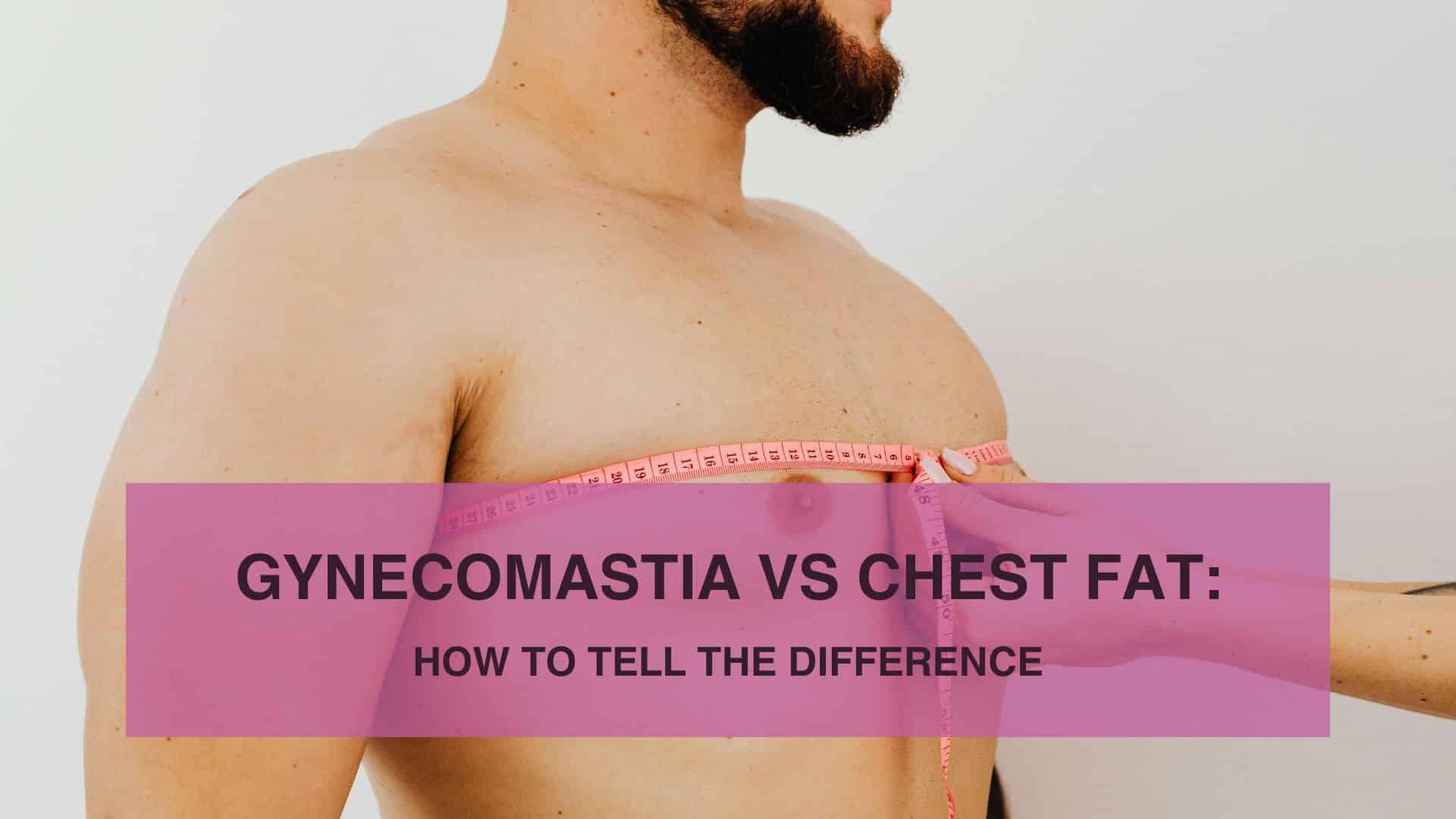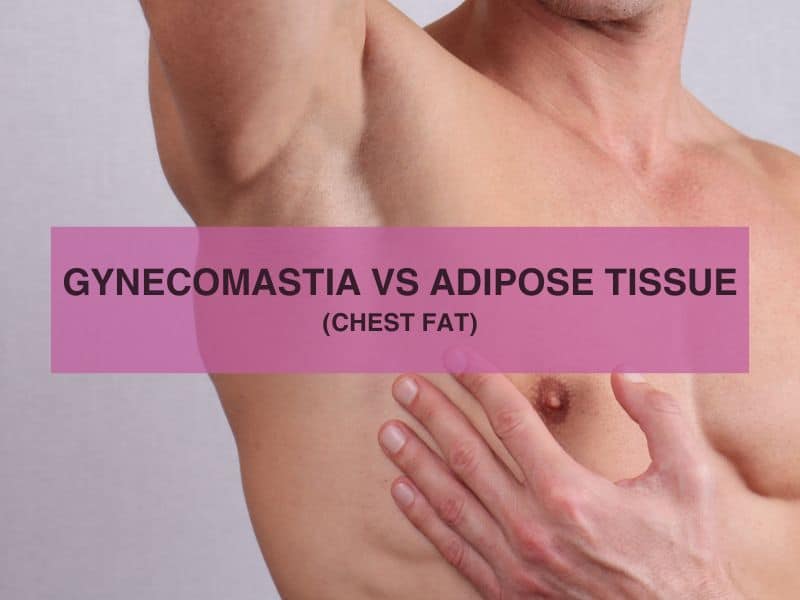Gynecomastia vs Chest Fat: How to Tell the Difference
Written by: Dr. Dahlia Rice. Posted in: Blog

If you’ve been noticing changes in your chest area, like increased fullness or puffiness, you’re not alone. Many men experience excess chest fat at some point in life, but understanding the difference between gynecomastia vs chest fat and other serious medical issues is crucial to your overall health and well-being.
So, the question is: are you dealing with gynecomastia, a medical condition involving glandular breast tissue, or is it simply body fat from weight gain? While they may look similar, the causes, gynecomastia treatment options, and implications are very different.
In this guide, we’ll break down what gynecomastia is, how it differs from chest fat, how to tell the difference, and what you can do about treating gynecomastia.
Table of Contents
ToggleWhat Is Gynecomastia?
In simple terms, gynecomastia is the medical term for the enlargement of male breast tissue due to excess glandular tissue and a hormonal imbalance, specifically, an increase in estrogen or a decrease in testosterone. This condition can affect breast tissue on both sides, sometimes unevenly.
In most cases, glandular breast tissue becomes enlarged during three life stages:
- Newborns (due to maternal estrogen)
- Adolescents (due to puberty-related hormone shifts)
- Older men (due to decreasing testosterone with age)
Overall, gynecomastia can be temporary or persistent and may be caused by excessive glandular tissue and other factors, including:
- Hormonal fluctuations
- Certain medications (e.g., steroids, anti-androgens, anti-anxiety meds)
- Alcohol or drug use (especially marijuana and anabolic steroids)
- Underlying health conditions (like liver or kidney disease)
Gynecomastia vs Adipose Tissue (Chest Fat)
Chest fat, on the other hand, is simply excess fat deposited in the chest region, usually as a result of fat cells accumulating :
- Overall weight gain
- Poor diet and lack of exercise
- Genetic fat distribution
Unlike gynecomastia, chest fat does not involve the development of glandular tissue. Instead, it’s part of overall body fat accumulation, which can affect the chest contour, and is more common in overweight or obese individuals.
Gynecomastia vs Chest Fat: Key Differences
Though they can look similar, there are a few major differences between gynecomastia vs chest fat. Here’s how to distinguish between the two using methods like the gynecomastia pinch test :
Cause
- Gynecomastia: Caused by a hormonal imbalance (increased estrogen or decreased testosterone).
- Chest Fat: Caused by overall body fat accumulation due to age and other lifestyle factors, like poor diet and exercise.
Tissue Type
- Gynecomastia: Involves glandular tissue that feels firm or rubbery to the touch.
- Chest Fat: Regular chest fat feels soft or jiggly when touched.
Feel
- Gynecomastia: Often presents as a distinct, disc-shaped lump directly under the nipple or male breast glands.
- Chest Fat: Feels evenly spread and lacks a centralized mass, possibly with a saggy or droopy appearance.
Location
- Gynecomastia: Centralized behind or around the pectoral region, often in the shape of a solid lump or disc.
- Chest Fat: Distributed broadly across the chest and upper body, may accompany an increase in overall body weight.
Symmetry
- Gynecomastia: May affect only one or both breasts or cause an uneven enlarged chest.
- Chest Fat: Typically affects both sides symmetrically, along with excess fat in other regions of the body.
Pain or Tenderness
- Gynecomastia: Can be sensitive or painful to the touch.
- Chest Fat: Chest fat responds to touch with no additional pain or discomfort.
Response to Weight Loss
- Gynecomastia: May persist even after implementing a healthy diet and exercise routine.
- Chest Fat: Often reduces with overall fat loss and targeted exercise.
How to Check for Gynecomastia at Home
If you’re unsure which you have,try a self-exam:
- Stand in front of a mirror: Take note of the size, shape, and symmetry of your chest.
- Pinch behind the nipple: Gynecomastia typically presents as a firm, rubbery mass directly beneath the nipple. Chest fat will feel soft and mobile.
- Check for tenderness: If it’s sore or painful, especially during touch or movement, it could be gynecomastia.
Remember, self-diagnosis isn’t foolproof. If you’re concerned, it’s best to consult a doctor for a professional assessment.
Can You Have Both?
Yes—it’s possible to have both gynecomastia and chest fat, especially in overweight individuals. In these cases, chest appearance may worsen due to the combination of glandular tissue and surrounding fat. This makes diagnosis and treatment more complex, but not impossible.
Diagnosis and Medical Evaluation
To confirm whether you have gynecomastia or chest fat, a healthcare provider will:
- Take a medical history (including medication use and symptoms)
- Perform a physical exam
- Possibly order blood tests to check hormone levels
- Recommend imaging (ultrasound or mammogram) if needed
In some cases, a biopsy may be performed to rule out breast cancer (though rare in men).
Treatment Options
For Chest Fat:
- Exercise: Focus on weight loss and strength training, especially chest-targeting exercises like push-ups, bench presses, and cable flys.
- Diet: Reduce caloric intake and eat a clean, protein-rich diet.
- Lifestyle changes: Cut back on alcohol and processed foods.
Chest fat generally responds well to lifestyle changes, although stubborn fat may require more targeted interventions.
For Gynecomastia:
- Watchful waiting: Puberty-related gynecomastia often resolves on its own as the body’s hormone levels adjust.
- Medication adjustments: If caused by a drug, your doctor may switch prescriptions.
- Hormone therapy: In select cases, medications like tamoxifen (an estrogen blocker) may help.
- Surgery: For persistent or severe cases, male breast reduction surgery (liposuction or gland excision) is a common and effective option. This requires insight from a board certified plastic surgeon to ensure the desired results.
Mental and Emotional Impact
Whether it’s gynecomastia or chest fat, body image concerns can take a toll on self-esteem. Many men report feelings of embarrassment, avoiding situations like swimming or intimacy.
If it’s affecting your confidence or mental health, don’t hesitate to talk to a doctor, counselor, or support group. You’re not alone, and treatment options are available.
Frequently Asked Questions:
1. Does gynecomastia go away on its own?
Sometimes. In adolescent boys, it often resolves without treatment in 6 months to 2 years. Gynecomastia in adults, especially if caused by medication or a health condition, it usually requires medical intervention.
2. Can working out reduce gynecomastia?
Exercise can help reduce fat and excess tissue, but it won’t remove glandular tissue. If you have true gynecomastia, you may need surgery to fully resolve it.
3. Is surgery the only cure for gynecomastia?
If the condition doesn’t respond to medication or resolve on its own, gynecomastia surgery is the most definitive option.
4. Can gynecomastia be a sign of cancer?
Rarely. While most cases are benign, a firm lump in one breast, especially with nipple discharge, should be evaluated by a doctor to eliminate the possibility of cancer cells in the breast tissue.
5. How long does male breast reduction surgery take?
Typically 1–2 hours, with a few weeks of recovery. It’s usually performed on an outpatient basis.
Still Have Concerns About Your Chest Fat?
Telling the difference between gynecomastia and chest fat is key to understanding what’s happening with your body, and taking the right steps forward. Gynecomastia involves hormonal changes and may require medical or surgical treatment. Chest fat, on the other hand, is typically a matter of diet and fitness.
If you’re unsure what you’re dealing with, don’t guess. Dr. Dahlia Rice has helped male patients in the Chicago area dissolve concerns around excess chest fat and restore their confidence with surgical treatment options and effective fat removal techniques. Contact her office to schedule a consultation today.
References:
https://www.mayoclinic.org/diseases-conditions/gynecomastia/symptoms-causes/syc-20351793
https://www.medicalcenterturkey.com/gynecomastia-pinch-test/


